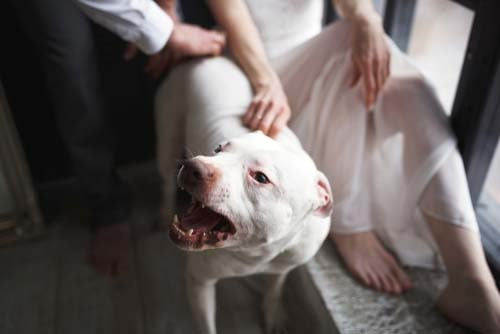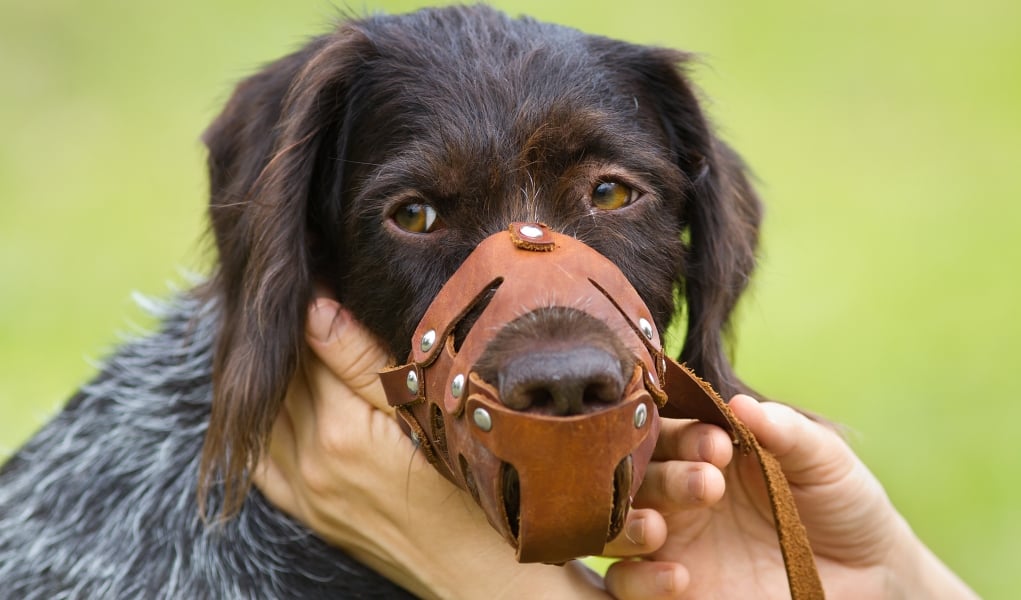A dog's aggression is one of the most common behavioral reasons that pet owners seek veterinary care.
Sadly, people just give up when they see their dog continue to exhibit aggressive behavior.
It's the number one reason dogs are surrendered to or returned to animal shelters.
Fortunately, dog training is very effective, specifically behavior modification techniques for dog aggression.
I'll just say this right now: training aggressive dogs SHOULD NEVER be done without the help of a professional dog trainer.
Still, some of these aggressive dog training tips can help you.
It is estimated that approximately 4.3 million people are bitten by dogs yearly. You DO NOT want to add to this statistic.
No matter how much you feel you trust your dog, he cannot be fully trusted if he shows signs of aggression.
When it comes to your dog's behavioral problems, minimizing the risks associated with an aggressive dog is essential.
It's of utmost importance for pet owners to understand what aggression in dogs means exactly, its causes, and ways to avoid and modify aggressive behavior in dogs.
Plus, you'll want to treat the behavior issues for the overall quality of life of your dog.
People, strangers, and neighbors treat the owner and dog poorly if the dog is aggressive.
They see it as a reflection of you.
Different Types of Canine Aggression
Before we go into my tips, you need to know the forms of canine aggression comes through.
Saying, “oh I know how to train an aggressive dog, I've seen Cesar Milan do it,” without having seen the signs and understanding dog agression is a bad plan.
You risk putting yourself, other people, and the dog at risk of facing the consequences all because of ignorance.
Let's go through the different ways dogs exhibit aggressive behavior and how to train for each:
Fear Aggression or Defensive aggression
Fearful dogs may be overly sensitive to people coming up from behind or when people try to pet them.
Fear aggression happens when a dog gets the feeling of being trapped or put in a corner with no escape from the trigger.
This is a complicated problem that is very common in dogs that were rescued from abusive homes and owners.
If you see this type of aggressive behavior, just know MANY rescues can be like this, and you're not alone.
However, it's imperative you begin with a certified pet behaviorist and begin fear-aggressive dog training methods.
Possessive aggression
This is also known as resource guarding. Dogs with this behavior will lash out when someone tries to touch their food bowl, toy, or even their owner.
This one is tricky and must be found out before interacting with people.
The last thing you want is a friend or family member that gets hurt because you didn't know your dog was possessive.
Territorial aggression
This aggression overlaps with possessive aggression. But dogs that have territorial aggression usually show aggressive behavior when they feel they need to let you know this is their space.
For example, my Dad's dog, Sasha, has no problem if you touch her food, toy, or my Dad. But if you are walking on “her” property and she doesn't know you, watch out.
When the usual lawn maintenance comes out to perform routine landscaping, we have to put her away until they're gone because she will try to nip at them.
Protective aggression
This is exactly how it sounds and can also be considered possessive aggression in a way.
Protective aggression dogs show aggressive behavior to protect their pack, whoever that may be.
Dogs are pack animals and have a group of people they consider part of their “pack”.
Dominance Aggression
This aggressive behavior is shown to “display dominance.” It is also known as status-seeking aggression.
As I said, dogs are pack animals and will protect their pack. They may feel the need to protect the hierarchy of that pack.
I'll give you an example.
Let's say a dog owner takes two dogs to the beach.
Naturally, as these dogs grew up together, one displayed more dominant traits than the other.
As things shake out, the hierarchy is established.
Now, this “pack” of two dogs goes to the beach, and other owners unleash their dogs at the beach, and a third or fourth dog wants to play with that original pack.
Uh oh.
That dominant dog then displays aggression towards those other two to let them know who the leader of the pack is.
Predatory aggression
This one is interesting and scary. If you have a smaller dog, it can happen to you. Fortunately, it's not common, but it can happen between larger and smaller dogs.
Normally, this predatory behavior is shown towards an animal because of the dog's desire to hunt and kill said prey.
For example, a bigger dog could show aggression toward small dogs because it believes it is prey.
Occasionally, it can happen with people and small children, depending on the circumstances.
Pain elicited aggression
This is aggressive behavior shown when the dog is experiencing pain.
I'll give you an example of pain-elicited aggression:
My wife used to have a dachshund named Chase.
Chase had a bad back because of an unknown injury.
He woke up one day and could no longer move, and when people tried to pick him up, his back would hurt so much he would try to bite you.
We believe it had something to do with him being overweight at the time and going up and down stairs.
Anyway, Chase had major back surgery that was extremely risky.
On top of that, he was in a really bad fight with another dog.
It's sad because, apparently, he used to be a nice dog.
But his back after the surgery and fight for the remainder of his life was never the same, and he would try to bite you if you picked him up in a way that hurt his back.
This tends to happen if male or female dogs have not been neutered or spayed.
When male dogs are around females that are having a heat cycle, aggression and chaos can ensue.
This usually happens when a dog does not get enough mental stimulation when at home.
Signs of Aggressive behavior
So before a dog goes to attack, they will give what they deem as warning signs.
These warning signs are a caution to the threat to stand down or leave the dog alone:
- The dog will freeze and become very still
- A dog will attempt to protect its private areas by putting their tail between their legs
- Pinned back ears aren't necessarily aggressive on their own, but it usually combined with other signs
- A dog's mouth seems to be tightly shut
- A dog that is threatened or displaying aggressive behavior will show their teeth
- They will do a low growl to start and get progressively louder to a snarl or barking
- They may lunge forward to the threat
- The hair on the nape of their neck down to their tail will stand up as if to create a bigger appearance.
- They may appear to try to get lower to the ground or bring their head lower.
- They may nip at said threat.
- They will deploy bites that give bruises or light puncture wounds, repeated bites at the target.
- They will do what is called a muzzle punch, where they “punch” another dog or person with their nose.
My 7 Tips For Aggressive Dog Training

No Punishment, Ever
Aggressive dogs or not, use positive reinforcement and positive reinforcement only.
The dog's health is priority number 1.
Use clear, strong commands that your dog is familiar with.
Be calm and reassuring.
Give the dog praise and positive reinforcement when your pup behaves properly.
For example, let's say your dog is aggressive toward another animal in your home.
When he chases, barks, or growls at that animal, use a clear and strong command for him to “Stop!” or “Sit!”
When a dog follows basic commands, reward him with a treat or praise.
Keep this up consistently, and be authoritative.
Establish your position in your dog's eyes by being in charge and not rewarding the dog when he/she misbehaves.
Bribery and distraction are quick fixes, but in the long run, they teach your dog doing naughty things will earn him a reward.
Which ultimately further incentivizes the pet's poor behavior.
When a situation appears where you expect your dog is going to be aggressive, immediately begin talking to him reassuringly.
Give him threats and make the situation into something positive instead of negative.
Once the situation passes, stop petting, do not give any treats, and stop talking comfortably to your dog.
He will eventually associate the stressful situation with a positive result instead of something that requires his aggressive reaction.
Seek Professional Help
I cannot stress this enough: aggressive dogs can be dangerous, and it's not recommended that you attempt to re-train the dog yourself.
While these dog training tips may be helpful, you're still at risk of things going badly.
As has happened many times (some stories from Dr. Jen), aggression in dogs can quickly lead to severe accidents.
The best thing you can do is seek the advice and help of a professional trainer, veterinarian, and canine behaviorist.
Behavioral dog trainers are generally available in most areas, but they usually don't all work with aggressive dogs.
Be sure to first call and chat with the trainer about your dog's specific needs and provide more information.

Underlying Reason and/or Triggers
You should consult your veterinarian to see if there is some psychological and/or medical cause behind your dog's aggressive behavior.
Medical issues are actually a common cause of aggression in dogs.
This is especially true if the aggressive behavior starts quickly or increases in intensity in a short period.
Some medical conditions that have been proven to cause aggression include:
- Hypothyroidism
- Cushing's Disease
- mast cell cancer
- urinary tract infections
- hip and elbow dysplasia
- arthritis
Some types of aggression may also be neurological.
Training is insufficient in cases where medical issues or neurological problems cause aggression.
Your veterinarian will set you up with a canine neurologist or a veterinary behaviorist that can help you diagnose and understand the issues.
Stay Calm, Speak Softly but Firmly
Research has shown that dogs can understand human emotions.
They take cues from our voice and body language to determine how we feel.
Have you ever noticed that your dog gets excited when you're excited or sad when you are sad?
He will sense if you're nervous when training an aggressive dog. If you're angry or frustrated, he will feel that too.
This could stress your dog even more and cause him to act aggressively.
One of the best aggressive dog training tips is to stay calm.
Speak in a normal tone and control your body language.
If you feel frustrated or anxious, take a break from the training until you can compose yourself.

Muzzles Are Beneficial
Dog muzzles are a controversial piece of training equipment, but they can be used for more than aggression only; you need to know what you're doing.
It is a common misconception that muzzles are only used to keep aggressive dogs from biting.
On the contrary, muzzles for dogs can be used for many different types of training, and they've been proven to be quite effective.
Remember, a muzzle is not an acceptable alternative to socialization and proper training.
You need to work with a trained professional if your dog shows aggression.
You should not be training an aggressive dog without experience.
Muzzles have become known to many dog owners as inhumane, but that couldn't be farther from the truth.
Muzzles do not hurt the dog and can be used to protect your dog, yourself, and other people around you while you're training.
A muzzle will make things easier and safer if you're trying to work with your pet around other animals or new people.
Using a muzzle during these training exercises will allow you to be more relaxed, which will also have a calming effect on your dog.
If something goes wrong and your dog reacts inappropriately, no one will get hurt because the dog's been wearing a muzzle.
This will give you peace of mind so you can be focused 100% on the aggressive dog training experience.
Desensitize SLOWLY
As with all types of dog training, desensitizing your dog to his aggression triggers will not happen quickly.
It's a process that must be done gradually.
Forcing your dog to get used to triggers too quickly is likely to result in an aggressive incident.
This incident could hurt you, your pet, or other humans/animals.
Take your time, be consistent, and work with a professional trainer or behaviorist.
An expert will help you understand what is causing the aggression so you can get to the root of the problem.
Create A Safe Environment for Training Your Dog
Dog aggression can only be exacerbated with lots of commotion and distractions going on.
This could agitate the dog and lead to frustration-elicited aggression.
It's important to find somewhere where there aren't any other dogs or people around where your dog could become distracted or triggered.
This doesn't mean that you never desensitize your dog but at the beginning and throughout the training process you want a controlled environment.
Spay or Neuter Your Aggressive Dog
Spaying or neutering does help with dog aggression.
In fact, sometimes dogs display sexually aggressive behavior like humping or mounting other dogs or people.
Which can easily be a problem if you have male dogs and female dogs.
For example, male dogs can become aggressive and agitated if there are female dogs in heat somewhere nearby.
My Favorite Dog Training Books for More Advice
The above tips on training aggressive dogs are simple.
However, if you're still having trouble with aggression in your dog and a trainer is not an option, you might want to read a more detailed guide.
There are many training books you can look into, and most of them have helpful advice.
My personal favorite is 101 Dog Tricks – it's simple and doesn't over-complicate things.
Other good dog training books you should try are these:
 Team Dog: The Navy SEAL Way by Mike Ritland
Team Dog: The Navy SEAL Way by Mike Ritland- Training the Best Dog Ever by Larry Kay
- Zak George's Dog Training Revolution by Zak George
- Lucky Dog Lessons by Brandon McMillan
Most of these books are written by respected dog trainers, so you know you're in good hands.
They contain detailed guides, additional tips, and plenty of photos to illustrate the author's point.
At the end of the day, dog aggression is the main reason dogs are sent back to shelters.
And the most important step you can take toward helping aggressive dogs is getting a professional dog trainer involved.
You will not and should not train an aggressive dog on your own.
The second most important thing is to have patience and understand rescues can have years of dog aggression built into their life.
READ NEXT: 15 Facts About Fear Aggression In Dogs You Must Know
Disclosure: We may earn affiliate commissions at no cost to you from the links on this page. This did not affect our assessment of products. Read more here and find full disclosure here.












